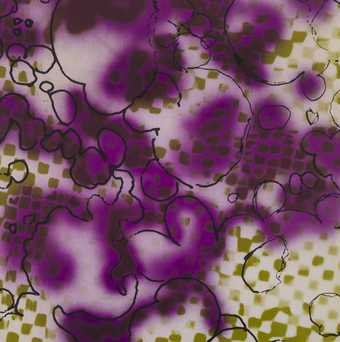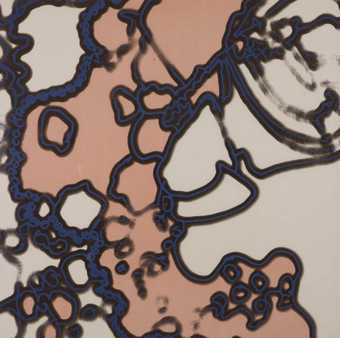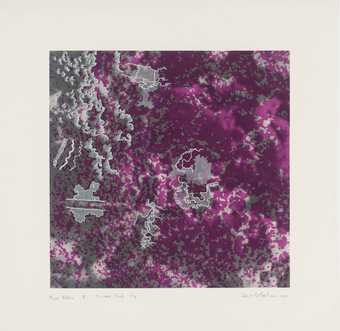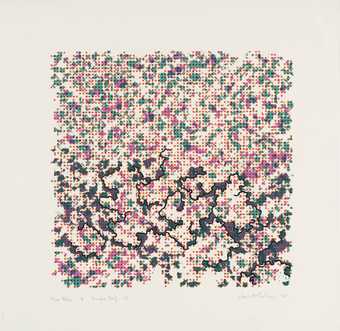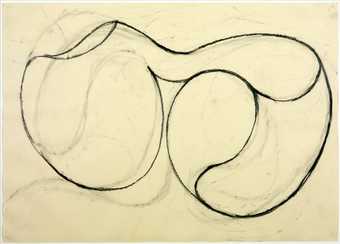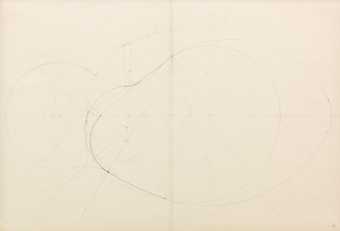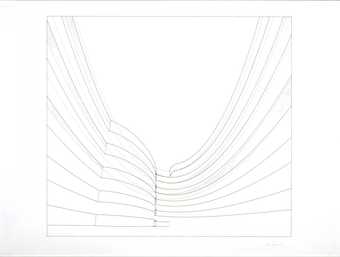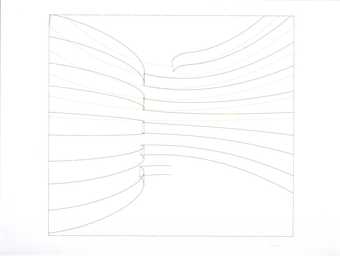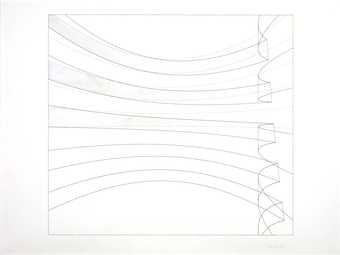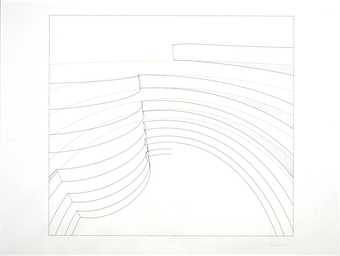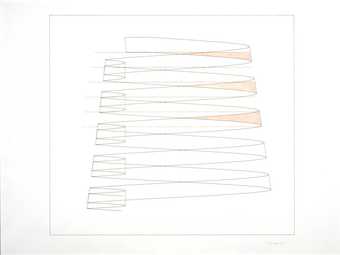
Not on display
- Artist
- Harold Cohen 1928–2016
- Medium
- Ink and textile dye on paper
- Dimensions
- Support: 575 × 765 mm
- Collection
- Tate
- Acquisition
- Presented by Michael Compton 1986
- Reference
- T04167
Display caption
Cohen first became involved with computer drawing in 1968, shortly after moving from London to Southern California to take up a one-year professorship at the University of California, San Diego. The following year the professorship was made permanent. In California, Cohen began to investigate the use of computers as a creative tool. Between 1973 and 1975 Cohen worked at the Artificial Intelligence Laboratory of Stanford University, California, where he began to 'write programs which would, in some important respects, do what human artists do when they make images'. The black ink outlines of the abstract shapes of 'Untitled Computer Drawing' were created automatically by a computer using one such programme. The forms were then hand-coloured.
Gallery label, September 2004
Does this text contain inaccurate information or language that you feel we should improve or change? We would like to hear from you.
Catalogue entry
T04167 Untitled Computer Drawing 1982
Black ink and textile dyes on machine-made, wove paper 575 × 765 (22 3/4 × 30); watermark ‘BFK RIVES | FRANCE’
Inscribed ‘Harold Cohen 1982’ b.r., ‘For Michael Compton, in friendship’ b.l. and ‘LW 25/82’ on back b.l.
Presented by Michael Compton 1986
Prov:
Given by the artist to Michael Compton 1983
Lit: Harold Cohen, ‘Introduction’ in Harold Cohen, exh. cat., Tate Gallery 1983, pp.8–9, 23; Deanna Petherbridge, ‘Random Acrobatics of a Technological Nature’, Architectural Review, vol.169, no.1037, July 1983, pp.51–2; Lawrence Campbell, ‘The Machine that Learned to Draw’, Art in America, vol.71, no.10, Nov. 1983, pp.206–7; Jasia Reichardt, ‘Machines and Art’, Leonardo, vol.20, no.4, 1987, p.371; Frank Dietrich, ‘The Computer: A Tool for Thought-Experiments’, Leonardo, vol.20, no.4, 1987, pp.323–4; Pamela McCorduck, Aaron's Code: Meta-Art, Artificial Intelligence, and the Work of Harold Cohen, New York 1991, pp.95–7
The black ink outlines of the abstract shapes were drawn automatically by a computer, programmed by the artist. These forms were then hand-coloured in red, orange, blue, purple, yellow, green, grey, pink, brown and turquoise textile dyes.
T04167 was made in 1982 in San Diego, California. Cohen first became involved in computer programming in 1968, shortly after moving from London to Southern California, to take up a one-year visiting professorship at the University of California, San Diego. The following year the professorship was made permanent and since then Cohen has lived and worked in San Diego. After arriving in California, Cohen began to investigate the use of computers as a creative tool and his knowledge of computer technology developed rapidly although he was largely self-taught. Cohen summarised his original interest in computer technology in his introductory essay to the 1983 Tate Gallery exhibition catalogue (p.7):
from my very first contact, I found myself fascinated, almost to the exclusion of everything else, by the decision-making power of programs. I was never fascinated by the machine ‘itself’ ... That condition has not been changed appreciably by having learned enough about machines, simply through using them, to fix them and to build my own. I have always had a profound preoccupation with how things work, however, and since the most remarkable ‘thing’ I know about is the human mind, it is perhaps unsurprising that I saw the program's decision-making abilities as an analogue for human intellectual activity.
Between 1973 and 1975 Cohen worked at the Artifical Intelligence Laboratory of Stanford University, Connecticut, under the guidance of Professor Ed Feigenbaum. Here Cohen developed his technical knowledge and began to ‘write programs which would, in some important respects, do what human artists do when they make images’ (ibid.). In 1973 Cohen wrote a program entitled ‘AARON’ which has dominated his subsequent work. Cohen has described AARON as an ‘expert system’ on image making, ‘the idea being that if one can wrest a significant body of knowledge from some expert ... and find some way of representing that knowledge so that a program can make use of it, then the program should be able to perform the way the expert performs’ (ibid. p.9). Moreover, Cohen suggests that AARON might be seen ‘not simply as a collection of expert knowledge about image-making’ such as knowledge of perspective, composition and materials ‘but as a speculative model both of the human memory in which such knowledge is stored, and of the processes which store, retrieve and modify that knowledge’ (ibid. p.11). The origins of the program's title is described by Pamela McCorduck in her extensive analysis, Aaron's Code: Meta-Art, Artificial Intelligence, and the Work of Harold Cohen, 1991 (p.120): ‘Aaron is Harold Cohen's Hebrew name, and since he anticipated writing a series of programs for generating art, he named the first of the series Aaron, beginning with “A”, the next program's name to begin with “B”, and so on. In fact, Aaron would remain Aaron, a program under continuous development for many years to come.’ The first hand-coloured computer generated drawing from Aaron was made in 1973 (repr. ibid., between pp.78–9 in col.).
Cohen wrote on 31 January 1995 in reply to a questionnaire sent by the compiler that the drawing was generated by the same version of the Aaron computer program used in his 1983 Tate Gallery exhibition. The computer hardware used for this exhibition was a Digital Equipment Corporation VAX-750, which was placed in a free-standing cabinet. The computer was linked to a terminal with a keyboard which was used for ‘starting drawings on the drawing machines’ (Tate Gallery exh. cat., 1983, p.8). Each of the four drawing machines were made by Cohen and were equipped with smaller computers to receive instructions from the VAX and to calculate how to drive the two motors which controlled the movements of pen across the paper. The artist wrote (ibid.) of the process:
AARON makes a very large number of unique drawings: in fact, with all four drawing machines running, the installation is capable of making about twelve drawings every hour throughout the exhibition. One program, thousands of original drawings. You will need to judge for yourself what significance to attach to this volume. No doubt we would agree that unless each individual drawing is worthy of attention - and not simply because it was made by a computer program - a thousand of them won't be either. If they are worthy of attention, though, the fact that they were generated by a computer program becomes significant.
For the duration of the exhibition AARON continued to produce numerous smaller works which could be purchased by the public visiting the exhibition. One of the drawings was enlarged to nearly sixty feet and then hand-coloured.
Cohen explained that AARON neither acts randomly nor produces replicas of drawings made by the artist in advance. Describing the program Cohen explained (p.9):
AARON is about as long as a short novel. Reading it wouldn't tell you a thing, though: computer code rarely has the same one-to-one relationship to its output as a musical score has to the sounds it generates. You should know also that AARON doesn't have any lexicon of shapes at its disposal. What it has is knowledge about how to do things, which sometimes results in shapes being generated, but more frequently results in strategies being followed: drawing a line around something, for example, or reinforcing an existing edge, or recognising that what's being drawn should be occluded by something which is ‘in front’ of it.
Cohen further suggested that AARON may be considered as ‘a collection of expert knowledge about image-making’ and as ‘a speculative model both of the human memory in which such knowledge is stored, and of the processes which store, retrieve and modify that knowledge’ (p.11).
‘Untitled Computer Drawing’ was given by the artist to Michael Compton, Keeper of Museum Services, at the time of Cohen's exhibition at the Tate Gallery in 1983.
This entry has been approved by the artist.
Published in:
Tate Gallery: Illustrated Catalogue of Acquisitions 1986-88, London 1996
Explore
- abstraction(8,615)
-
- non-representational(6,161)
-
- colour(2,481)
- irregular forms(2,007)
- formal qualities(12,454)
-
- chance(1,450)
You might like
-
Harold Cohen Close-Up IV
1966 -
Harold Cohen Close-Up VI
1966 -
John Walker Drawing No. C
1981 -
Harold Cohen First Folio B
1965 -
Harold Cohen First Folio E
1965 -
Richard Deacon Untitled Drawing
1980 -
Richard Deacon Untitled Drawing
1981 -
Tim Head Drawing for ‘Project for Guggenheim Spiral’
1980 -
Tim Head Drawing for ‘Project for Guggenheim Spiral’
1980 -
Tim Head Drawing for ‘Project for Guggenheim Spiral’
1980 -
Tim Head Drawing for ‘Project for Guggenheim Spiral’
1980 -
Tim Head Drawing for ‘Project for Guggenheim Spiral’
1980 -
Tim Head Drawing for ‘Project for Guggenheim Spiral’
1980 -
Tim Head Drawing for ‘Project for Guggenheim Spiral’
1980 -
Basil Beattie Untitled Drawing
2000

